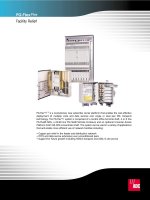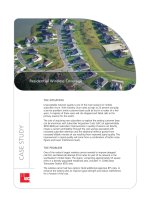Tài liệu In-building Wireless docx
Bạn đang xem bản rút gọn của tài liệu. Xem và tải ngay bản đầy đủ của tài liệu tại đây (805.89 KB, 20 trang )
PLANNING GUIDE
In-building Wireless
A Deployment Guide for Wireless
Service Providers
Page 2
Welcome to the
In-building Wireless
Deployment Guide for Network Managers
What’s inside counts. That statement sums up customer expectations about
wireless service inside offices, homes and public places such as malls, hospitals
and subway stations. Wireless service providers have a vested interest in meeting
those expectations: When consumers and business users are convinced that
indoor coverage is reliable and nearly ubiquitous, they’re far more likely
to believe that their mobile phone can be their only phone. That belief helps
wireless carriers’ bottom lines by increasing average revenue per user (ARPU).
Many wireless service providers are aggressively expanding their in-building
coverage. In fact, this trend is a major reason why the in-building market will be
worth $1.3 billion by 2009, according to a June 2006 report by Visiongain, an
independent analyst firm. The report notes: “The need for improved voice quality
in homes, offices and other buildings, as well as increasing usage of mobile data
networks indoors, are driving this growth of cellular and wireless in-building
solutions. Upwards of 70 percent of 3G data traffic originates indoors and
adopting the right strategy can help operators alleviate network capacity issues
while at the same time boost data ARPU and reduce churn through
service differentiation.”
Other analyst firms are equally optimistic. For example, a December 2006 ABI
Research report forecasts the in-building market to grow 20 percent annually, to
more than $3.6 billion by 2011.
In-building voice and data usage have steadily increased over the past several
years. In 2005, 67 percent of all business users’ wireless data sessions and voice
calls already were made indoors, according to a Strategy Analytics survey. Those
usage habits have become more common since then, and they highlight the
importance of reliable, seamless indoor coverage for wireless service providers
targeting the enterprise market.
Page 3
The purpose of this guide is to provide you with an
understanding of the issues surrounding in-building
wireless solution implementation, including:
• Whatarethechallengesindesigningandexecuting
in-building wireless projects?
• WhatfactorsaffecttheirROIandongoingcosts?
• Howcanmultipleentitiesshareconstructionand
operational costs?
• Whatisthebusinesscaseforin-buildingwireless?
It is our goal to help you implement more solutions
seamlessly, economically and quickly. If you don’t have
the answers to some of these questions, or if you lack
a complete understanding of in-building wireless,
this guide is a great place to start.
Charting the Future Direction
of In-building Wireless
This In-building Wireless Guide is designed as a hands-on
reference document. We invite you to share this guide
with your staff and use the information to build your
own “Blueprint for In-building Wireless Success.”
It has the potential to help you and your staff in the
following ways:
• GainaholisticapproachtoRFplanningandsolution
integration.
• Identifyopportunitiesforusingin-building
wireless to improve your competitive position
and bottom line.
• Aidsolutionselection.
• Minimizeimplementationdelaysandcosts.
How to Use the Deployment Guide:
Sections 1 through 4
The guide is divided into four easy-to-navigate sections.
Although this format allows you to pick and choose
which sections to view, the most effective way to use this
document is to work through each section in order.
You will be asked to complete an in-building wireless
audit, which offers the dual benefit of allowing you to
document your current situation and providing ADC with
the necessary information to answer your tough indoor
wireless questions. This audit will ultimately streamline
the process, creating faster time-to-market and increased
customer satisfaction.
The guide also provides you with insight into design
choices for effective in-building wireless infrastructure,
as well as case histories from real-world indoor wireless
implementations.
Section 1
Auditing Your In-building Wireless Deployment
Section 2
Service and Technology Considerations
Section 3
Your Blueprint for In-building Wireless Success
Section 4
Case Studies: In-building Wireless Deployment Scenarios
Note: You will encounter many acronyms throughout this
document. Although they will be defined along the way,
an acronym key is provided in the appendix.
In-building Wireless: A Deployment Guide for Wireless Service Providers
In-Building Wireless: A Deployment Guide for Wireless Service Providers
Page 4
Section 1: Auditing Your
In-building Wireless Deployment
A successful in-building wireless deployment begins
with building a solid foundation. Your partner requires a
thorough understanding of your needs and priorities. In
Section 1, we examine the objectives of your in-building
wireless deployment, objectives of the venue or other
stakeholders, your network infrastructure considerations,
and the operational requirements you may face.
Typical preliminary questions include:
Product Considerations
1.) At what stage is your in-building wireless project?
oActivating service
o Vendor selection
oCollecting information from vendors
oSecuring funding/budgets
oOther
2.) What business challenges led you to consider
in-building wireless? (Check all that apply.)
oCustomer service for existing Enterprise
o Gain MOUs public venue
o Stressed Macro (capacity, pilot pollution)
o Hostneutral/plantolead
o Contractual requirement
o Other, please describe ______________________
_________________________________________
3.) What are the most critical in-building wireless
challenges that you want to overcome?
(please describe) _____________________________
___________________________________________
___________________________________________
___________________________________________
___________________________________________
___________________________________________
4.) What process will you use to select vendors?
oRFI
oRFP/RFQ
o Sole source
5.) What is your timeline for deploying in-building
wireless? (See Project Timeline in appendix)
oDeploying now
oIn the next 6 months
oIn the next year
oConsidering / contract or pending funding
6.) What are your preliminary solution preferences?
oActive Distributed Antenna System (DAS)
oPassive DAS
oRepeater
oPico or microcell
oOther __________________
Facility and Installation Considerations
7.) What is the type of facility? (Check all that apply.)
oOpen/warehouse
oIndustrial/Manufacturing
oCubed office
oDrywall office
oHi-risebuilding
oGovernment building
oHospitalbuilding
oMall
oAirport
oConvention center
oStadium/Arena
8.) What is the estimated number of subscribers within
the venue? __________
9.) Howmanybuildingsareinthisfacility? __________
10.)Whatistheapproximatesizeofthisfacility?
(list per building)
____________ square feet
____________ square feet
____________ square feet
____________ square feet
11.)Howmanyfloorsdoesthisfacilityhave? _________
If more than one venue, please describe each. ____
___________________________________________
___________________________________________
___________________________________________
___________________________________________
In-Building Wireless: A Deployment Guide for Wireless Service Providers
Page 5
12.) Are floor plans available?
oYes
o No
13.) Is existing cable infrastructure available?
o No
o Yes, single-mode fiber
o Yes, multi-mode fiber
o CAT3/5 cable
o CATV
o Coax
14.) Is installation of conduit/innerduct required?
o No, existing
oYes, why required _________________________
_________________________________________
15.) Are plenum-rated cables required?
o Yes
o No
16.) Are dust tents/partitions required
(clean room environment)?
o Yes, describe where and why ________________
_________________________________________
_________________________________________
_________________________________________
o No
17.) Are there any special work instructions?
o Union labor required
o Incumbent installer
o Building restricted access, security
o Off hours
o Asbestos or other environmental issues
o Other work restrictions, please list ____________
_________________________________________
_________________________________________
_________________________________________
_________________________________________
18.) Is high lift equipment required for installation?
o Yes, describe coverage areas ________________
_________________________________________
_________________________________________
_________________________________________
_________________________________________
_________________________________________
o No
19.) Are there any special installation requirements?
(Examples could include architectural, aesthetic and
historical considerations.)
o Yes, please describe ________________________
_________________________________________
_________________________________________
o No
RF Considerations
20.) What is your design goal in terms of dBm? _______
_________________________________________
_________________________________________
21.) Which bands are in use? And what is the number
of RF carriers per band?
o700MHzpublicsafety_______________
o800MHzSMR_______________
o 800MHzcellular–Aband_______________
o 800MHzcellular–Bband_______________
o 900MHzSMR_______________
o 900MHzGSM_______________
o 1800MHzDCS_______________
o 1900MHzPCS–Aband_______________
o 1900MHzPCS–Bband_______________
o 1900MHzPCS–Cband_______________
o 1900MHzPCS–Dband_______________
o 1900MHzPCS–Eband_______________
o 1900MHzPCS–Fband_______________
o AWS1700/2100MHz_______________
o 2100MHzUMTS_______________
oOther services_______________
In-Building Wireless: A Deployment Guide for Wireless Service Providers
Page 6
22.) What is the access protocol and number
of RF carriers?
o TDMA_______________
o GSM-TDMA_______________
o CDMA_______________
o WCDMA/UMTS_______________
o iDEN_______________
23.) Does this project require support for multiple service
providers and/or multiple access protocols?
o Yes, please describe ________________________
_________________________________________
_________________________________________
_________________________________________
o No
24.) Are there any other in-band services
or known interferers?
o Yes, please describe ________________________
_________________________________________
_________________________________________
_________________________________________
o No
25.) What is the RF source?
oRemote off-air interface
oLocal BTS/Node B interface
onanoBTS(IP–picofeed)
oRemote BTS feed
It is important to identify your top priorities when
selecting a solution. A partner like ADC who offers
a wide-range of products from repeaters, indoor DAS,
outdoor DAS, pico and microcells, structured cabling,
andserviceswillbeabletocustomizeasolutionbased
on your priorities.
Section 2: Service and
Technology Considerations
Quality of service (QoS) can be a powerful market
differentiator. Seamless, reliable in-building coverage is
a key component of a wireless service provider’s overall
QoSstrategy.Herearesomekeyconsiderationswhen
developing and executing in-building wireless projects:
Create and Maximize Revenue Opportunities
Customers can’t use what’s not available. Simply put,
revenue opportunities are often lost when customers
frequentareas–suchasinsideofficebuildingsand
malls–wherethere’softennosignaloronethat’s
marginal. With growing consumer reliance on mobile
communication devices and the increasing sophistication
of available services particularly with business users,
in-building coverage and capacity is becoming the
primary focus for network improvement.
Wireless operators have two primary types of
deployments, both of which can benefit from in-building
wireless solutions. The first type is public areas, where
reliable, seamless coverage indoors and out is key to
attracting and retaining consumers, adding incremental
MOUs and improving QoS. The second primary type is
private areas, such as office buildings and campuses.
Good in-building coverage is an asset for wireless
operators targeting the enterprise customer and
displacing wireline services. In both deployment types,
wireless operators can use in-building systems to build
consumer confidence that the network providing those
voiceanddataservicesisreliableandnearlyubiquitous–
indoors and out.
In some cases, providing an in-building wireless system
may be the only way to land a major customer. A prime
exampleishealthcare:Historically,hospitalsandother
health care facilities typically required that employees’
and/or visitors’ phones be shut off in many areas, due
to concerns about interference with medical equipment,
obviously disturbing or interrupting service. Those policies
significantly reduce ARPU. But a well-designed in-building
wireless system allows mobile phones to remain on
in more areas by reducing the handset power to the
minimum necessary to maintain a reliable connection.
That can mitigate concerns about interference with
medical equipment, leading to relaxed policies and in
turn increasing ARPU. Reliable indoor coverage also
increases the value of wireless in the eyes of health
care CIOs and IT managers. More importantly, medical
staffs are able to migrate to more sophisticated devices
and communicate reliably.
In-Building Wireless: A Deployment Guide for Wireless Service Providers
Page 7
Reduce Overhead Costs
An in-building wireless system can reduce overhead
costs in a variety of ways. For example, it can reduce
the traffic load on the macrocellular network to the
point that additional base stations may not be necessary.
Considering that a new base station can cost $250,000
or more, with backhaul and site leases adding to that
cost, the savings can be significant.
Another example is how solid indoor coverage can
improve data performance. If bandwidth-intensive
applications such as streaming multimedia have access to
a good signal, it makes for a better user experience. Just
as important, a good signal reduces the number of lost
and corrupted packets, in turn reducing the number that
have to be resent. As a result, the operator may not need
to upgrade its network capacity because the current
infrastructure isn’t wasted on unnecessary tasks such as
resending packets. Those savings also free up capital that
can be spent on revenue-generating projects.
In-building systems also can be a cost-effective way to
accommodate high voice and data usage. For example,
instead of splitting macro cells or adding capacity to
macro cells, deploying an in-building system can offload
some of that traffic. That approach frees up capacity
on the macrocellular network improving the customer
experience indoors and out.
Finally, reliable indoor service also reduces customer
complaints and churn, so the operator may have lower
customer-acquisition costs because it isn’t constantly
trying to replace customers who have left. Fewer
customer complaints also can reduce the need to staff up
call centers, issue service credits or both. A side benefit
of reduced churn and lower customer-acquisition costs
is that investors closely monitor these metrics when
assessing a wireless carrier’s competitive position.
Identify All Variables
Proposals are only as accurate as the information on
which they’re based. Identifying all variables up front is
the best way to avoid change orders, which can cause
project costs to spiral out of control, undermining the
business model. Overlooking variables also can delay
time-to-market and the ROI. The worst-case scenario is a
lengthy work stoppage caused by variables that should
have been identified up front.
Site surveys are highly recommended for identifying
structural and environmental variables.
Table 1 lists some common environmental factors to
consider in old and new buildings.
Table 1: Old Buildings vs. New Buildings
• Olderbuildingsmayhaveasbestos,whichrequires
special consideration when, for example, the material
is in areas where cables must be pulled or where holes
must be drilled.
• Newerbuildingsoftenhavefloorplansthatare
available in electronic form, such as Auto-Cad
drawings.However,it’simportanttocheckwhether
those plans have been updated to reflect any
remodeling or additions since the initial construction.
• Inbotholdandnewbuildings,checkwiththeIT
department or other entity that’s likely to know where
fiber is and isn’t available, as well as type(s) used. If
existing conduit doesn’t have extra room for additional
fiber pulls, determine the amount that will have to be
added. Also, determine whether additional conduit
isnecessaryonlyonverticalsoronhorizontals,too.
Besides fiber, identify other infrastructure that can
be leveraged in order to reduce costs and installation
time. Examples include the facility’s Cat5 plant and
local power.
Old Buildings New Buildings
Signals typically propagate
through floors
In-building signals stay
inside, while macrocellular
signals stay outside,
due to attenuating features
of building materials such
as foil-faced insulation and
metallic window tinting
Higherlikelihoodof
core drilling required;
not designed for cable
infrastructure; no
Telco closets
Generally facilitate cable
installation; interstitial
space; typically have
stacked Telco closets
Fiber runs may be longer
than anticipated (no way
to get there from here)
Higherlikelihoodofavailable
fiber backbone
Higherlikelihoodthatfacility
has hard-to-install ceiling
construction such as
hard pan
Drop-ceiling and/or air duct
ceiling more common
May have historic
preservation requirements
(e.g., protect woodwork)
and aesthetic requirements;
Asbestos abatement
Higherlikelihoodof
clean-room requirements
Often have many additions/
exterior walls on the interior;
floor plans may show the
facility as one complete
floor when in reality they
are separate facilities
adjoined; for this
circumstance there is no way
to quickly/efficiently model
Typically have Auto-Cad
drawings, but often not
updated when facility
changes occur
In-Building Wireless: A Deployment Guide for Wireless Service Providers
Page 8
Focus on Solutions
A sound and ideal in-building wireless solution typically
requires propagation analysis, system design, site surveys,
coordinationofinstallationservices–whichmayinclude
unionlaborandvalue-addedresellers(VARs)–andall
hardware. The solution also should include accountability,
with clearly defined benchmarks for measuring success.
Hence,itisimportanttochooseapartnerthat’scapable
of providing a comprehensive, turnkey solution.
There are several technical solutions available for
in-building wireless coverage and capacity. They include:
pico and microcells, high and low powered repeaters,
passive coax-based transport, and low and high powered
active DAS. Before selecting a specific solution or
combination of solutions, it is important to consider the
following:
• Istheneedcapacity,coverage,orbothinnature?
• Whatisthesizeandtypeofvenue?
• Howmanywirelessserviceprovidersdoesthesolution
need to support?
A sound understanding of these needs along with
the reconciliation of the business criteria and venue
requirements, will guide you to the appropriate
technologies.
Determine Ownership and Set Expectations
Different environments have different requirements.
That goes without saying, but it bears repeating because
in some cases, the landlord or enterprise may want an
in-building solution that’s operator- and/or technology-
agnostic. A related issue is which entity pays for and
owns the in-building system.
It’s critical to identify ownership and the owner’s
requirements up front because they affect design
considerations. For example, sharing power amplifiers
may require additional remote units, which translates
into additional hardware and labor costs. By comparison,
a discrete system may be easier to design and manage
because it’s easier to mitigate interference and eliminates
ownership and maintenance questions.
Identifying the variables discussed earlier in this section
is a highly effective way to set expectations before the
project gets underway. Setting expectations also avoids
scope creep. Other important considerations are:
• Identifyandagreetoallrequirementsupfront.
Once the project is underway, changes and additions
become change orders, which can be expensive
and time-consuming.
• Thefacilities-maintenancedepartmentcanbea
good source of information about ceiling types
because they’ve encountered them while installing or
maintainingHVACductwork.Thisdepartmentalso
should be able to provide information about what’s
above ceilings.
• Notetheceilingheightsinallareaswherein-building
coverage is required. Do they require more than just
a standard 8- or 10-foot stepladder to reach? If so,
factor in additional costs, such as renting scissor lifts.
Check with facilities management to see if a scissor lift
is already on site and can be borrowed for the project,
although insurance requirements might not allow it.
• Identifyuniquebuildingfeaturesthatwillaffect
coverage and propagation, such as long hallways
with offices on both sides, or banks of metal lockers.
Hospitalstypicallyhaveafewroomswithlead-lined
walls, such as X-ray rooms.
• Lookforcleanrooms,whicharecommoninawide
variety of facilities, ranging from hospitals to hotels to
data centers. A good rule of thumb is that the older
the facility, the more likely that it will include areas
that can’t be covered in dust, such as when drilling
holes, or floors tracked by a scissor lift. Factor in time
and budget for preventive measures such as tenting,
which generally require a two-person team. A two-
person team more than doubles labor costs and the
project’s time frame.
• Whereverpossible,notethebuildingmaterials.For
example, plaster walls typically have embedded wire
mesh, which reflects signals at cellular frequencies
suchas850MHzand1900MHZ.Bycomparison,
drywall typically reflects only a small percentage of the
signal. Offices built over the past few decades tend to
have windows with metallic tinting, which routinely
attenuate signals by 20dB or more.
• Lookforpartsoftheenvironmentthatcanbemoved
orreconfigured,suchaspalletracksandmezzanines.
These typically are made of steel, which means that
they’ll affect propagation. So if they’re moved or
removed, signal coverage almost certainly will be
altered–andnotnecessarilyforthebetter.Evenlarge
wooden benches, which may absorb signals, can be a
factor.
Another key consideration is installation labor, which
typically is 40-50 percent of the system’s cost. Refer to
the audit in Section 1 for labor-related considerations.
It’simportanttorecognizethatsomeorallofthese
variables might exist in your project. Identifying as
many of them as possible as early as possible significantly
reduces the chances that you’ll be surprised later on by
delays and additional costs.









